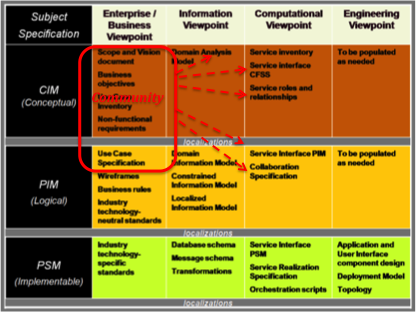 |
Page History
| Scrollbar |
|---|
...
Both the UML use cases and the ODP community concept can be used to capture business requirements.
...
The similarities and differences are summarized in Table 4.2-1 below.
ODP community concept | Use case concept |
|---|---|
Community contract | None |
Community Objective | Use Case purpose |
Role (of a User) | Actor |
Role (of a System) | System |
Community Behavior
| Use Case |
Policies | None |
Enterprise Object
| None |
Table 4.2-1 ODP Community concept and Use Case models – High Level Comparison
...
- The Scope and vision document, mostly narrative text, but identifying the business problem, key stakeholders and communities. The communities can be related to each other (or not), and each community should have its business objective stated.
- The Business Objective of each of the communities, which in turn consists of a related set of use cases; note that an enterprise specification (e.g., of a specific caBIG domain) can consist of several communities, leading to several business objectives; these in turn can be related to a higher level objective, as required.
- Grouping and structuring of the several related use cases from the use case inventory (and the corresponding use case specifications), where a 'related use case' is the one that includes the same user and system roles.
Figure 4.2-1 Community Traceability in the ECCF Matrix
...
- A Domain Analysis Model (information viewpoint/CIM cell), through the information artifacts used and exchanged between roles in the community
- Service interfaces and Service role/relationships (computational viewpoint/CIM)), via community roles
- Collaboration specifications (computational viewpoint/PIM cell), via community roles and interactions, as for example shown in Figure 4.1-1.
- PIM service interfaces (computational/PIM cell), through services offered by community roles filled by systems and identified, for example, as part of the UML analysis and design as discussed in section 3.2 - Use Case Realization.
It is through this traceability mechanism that each of the detailed use cases can be subsequently linked to the NCI Enterprise Services. A UML diagram outlining relationships between use case and community modeling concepts is found on the main page of this report.
...
